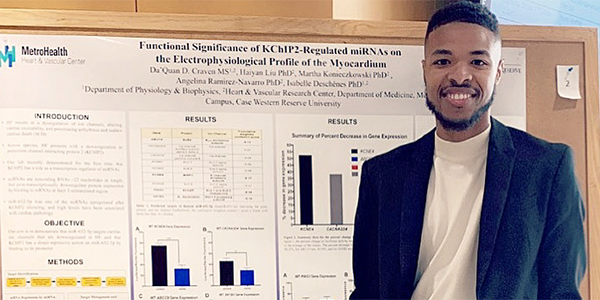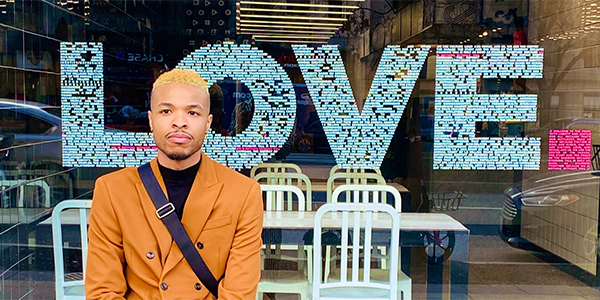Dancing Through Adversity
New Member Da’Quan Craven on Diversity, Confidence, and the Anatomy Class that Changed His Career
By Sheryll Poe
This article was originally published in the February, 2021 edition of the Anatomy Now newsletter.
Talking to him today, it’s hard to believe that Da’Quan Craven has ever had an issue with confidence. He’s a funny, chatty, charismatic, proudly gay Black man who admits his favorite form of self-care is hitting the dance floor in the latest fashions. (He almost went to design school).
On top of that, Da’Quan has two masters degrees and is currently working on a PhD in Anatomy, Cell Biology and Physiology at the Indiana University School of Medicine.
After graduating high school in Flint, Michigan, with a passion for science but only a 2.7 GPA, Da’Quan said he felt a little discouraged. “My high school performance was very poor and what comes with that is confidence issues,” Da’Quan explained. “When I was younger, I thought GPA determined how smart I am, and according to this, I’m not very. It’s going to be rough. When I got to college, I didn’t think I was smart enough for pre-med so I didn’t try.”

Da'Quan Craven presents a poster at Case Western Reserve University
Discovering Anatomy – and His Abilities
It was his first Anatomy & Physiology class at the University of Michigan-Flint that gave Da’Quan the confidence he needed to pursue a career in anatomy. The professor, Elizabeth Malinowski, was known to be very tough. “Other students warned me she was the hardest in the department, it’d be terrible, and I’d be lucky if I got a C!,” he remembered. “I go into the class, a big lecture class, and my instructor is going through the notes and using anatomical terms I’d never heard of. I’m like, ‘I’m going to fail. What am I going to do?’ and then I saw on the syllabus her contact info and office hours, for students who needed help.”
Da’Quan took Malinowski up on that offer and got extra help to get through that first semester. That positive interaction not only boosted Da’Quan’s confidence, but also ignited a love for anatomy. “On my Teach for America application, they asked what your greatest accomplishment was, and I proudly listed getting the A-minus in that class,” Da’Quan said. “It showed me that not only is this area of science cool, but it’s doable. Because I had a professor who encouraged me.”
When he was still an undergrad, Da’Quan joined the Minority Association of Pre-Medical Students (MAPS) and attended the Student National Medical Association’s Annual Medical Education Conference (AMEC) in Washington, DC. While there, he sat in on his first gross anatomy lab at Howard University. “I was so fascinated, especially because a Black PhD student gave our tour,” Da’Quan noted. “That is also the first time I recognized that a person could get a PhD in anatomy. Up to that point, I’d always thought anatomy was only a course to be taken as a prerequisite for health careers.”
Blazing a Trail
After getting a masters in pharmacology from the University of Michigan and a masters of medical physiology from Case Western Reserve University School of Medicine, Da’Quan set his sights on getting a PhD. He recently completed his first semester as the first Black student to participate in Indiana University School of Medicine’s Anatomy, Cell Biology, & Physiology PhD program. “At first, being the first Black doctoral student in anatomy was a bit overwhelming, especially considering the recent state of social justice in the country and the role of race in the elections. That made it less something I was excited about and instead created pressure to be perfect,” Da’Quan pointed out.
One of Da’Quan’s driving goals is to “make science more inviting for more Black people,” which is why his dissertation will be “an evaluation of post-baccalaureate pre-medical programs that are targeted at academic record enhancers for minority students…the majority of the Black students who enter medical school come from post-baccalaureate programs, which suggests they might be very important for diversifying the physician workforce. Which means someone should be making sure that they’re doing what they’re supposed to be doing: getting students into medical school.”
Finding Future Scientists
Finding diversity in science was also one reason Da’Quan joined AAA last year. “I had Tweeted early on about finding other Black people in anatomy. AAA Executive Director Shawn Boynes Tweeted back and recommended that I go through the association directory and find people for networking.” Da’Quan is now helping create events and conversations with @BlackinAnatomy. “Body donors aren’t very diverse. And for Black people, that has historical roots. So I’m spearheading an effort within @BlackinAnatomy to create a more trusting relationship with the Black community, with a goal of increasing willed body donations to diversify the cadavers future health students have to work with,” he explained.
Before going to IU, Da’Quan spent a year in Washington, DC. as a founding teacher at KIPP DC Somerset College Prep, where he helped develop and deliver the STEM curriculum for the charter school. He’s now taking that experience and developing a summer program to get students, specifically Black youths, involved in “not only anatomy, but also learning theory to make them better students and engaged in science.”
When he’s not in the classroom, the lab, tutoring other students in pharmacy and biochemistry, or taking and teaching classes virtually, Da’Quan is working on his dance moves for the post-COVID-19 world he hopes we all can get back to soon. “When the world was regular, one of my favorite activities was to go to brunch and a day party – someplace where I could dance and eat my food and show off the latest fashions,” Da’Quan reminisced. “What dancing does for me is rejuvenate my spirit and gets me motivated. It recharges my batteries.”

Finding Future Scientists
Finding diversity in science was also one reason Da’Quan joined AAA last year. “I had Tweeted early on about finding other Black people in anatomy. AAA Executive Director Shawn Boynes Tweeted back and recommended that I go through the association directory and find people for networking.” Da’Quan is now helping create events and conversations with @BlackinAnatomy. “Body donors aren’t very diverse. And for Black people, that has historical roots. So I’m spearheading an effort within @BlackinAnatomy to create a more trusting relationship with the Black community, with a goal of increasing willed body donations to diversify the cadavers future health students have to work with,” he explained.